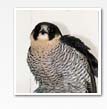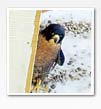Peregrine Falcon Recovery Program
Click here to read
Parkland Mews Recovery Plan in PDF Format
The Peregrine Falcon Falco peregrinus is a migratory
bird of prey that inhabits the tundra, boreal forest, prairie, agricultural
areas and urban settings in Manitoba. Berger and Nero (1992) state
the following: “The available evidence indicates historically,
the Peregrine Falcon should be regarded as a rare but indigenous
nesting species in Manitoba.”
Species Information
Scientific Name: Falco peregrinus anatum
Common Name: Peregrine Falcon.
Current Manitoba Status: Endangered.
Breeding Range in Manitoba: Southern Manitoba.
Rationale for Status: A sudden decline in the known breeding population.
Known Number of Nesting Sites in Manitoba
Six sites. Five urban and one rural (historic).
Rate of Population Decline
Manitoba Peregrine Falcon nest occupancy peaked in 1995 with a total
of four breeding sites being documented as active. From this peak,
occupancy dropped to three for the next two years and fell further
with pairs present at two sites 1998-2000. In 2001, a single site
remained occupied by a mother and son pairing. This represents a
decline of 75% of the known breeding population within seven years.
The cause of recruitment failure is unknown despite a successful
breeding and release program for the mid- west continent during
the period.
Potentially Limiting Intrinsic Factors
Early mortality is the single biggest limiting factor facing Peregrine
Falcons in Manitoba. There are numerous causes that can be attributed
to this early mortality such as starvation due to a lack of necessary
hunting skills or sufficient prey. Peregrines do not normally nest
until the age of two. During this time there are long annual migrations
to and from their wintering grounds in Central and South America.
First year mortality has been estimated as high as 70%. Of the 138
Peregrines documented leaving Manitoba, 12 were known to have completed
the round trip. These figures represent both hacked and wild-bred
birds over a time span of two decades. For this reason a large part
of the strategy does target life history features such as juvenile
mortality and migration as a conservation focus.
Threats
Great Horned owls and mammalian predators appear consistently in
the literature regarding threats against Peregrine Falcons. An emerging
threat to birds of prey is the West Nile Virus. What impact, if
any, this poses for Peregrines is yet to be determined. However
for Peregrines held in captivity the virus could prove to be problematic
unless a vaccine can be developed in time. Climatic factors such
as extreme cold at unseasonable times of the year may cause egg
failure. Young dispersing from urban nest sites surrounded by agriculture
areas with grain crops typical of southern Manitoba landscapes could
be at risk. Peregrines on formative flying excursions may be prevented
from opening its wings if landing in a field containing tall stem
crops such as wheat or sunflowers. Collisions are a significant
factor of early mortality in young Peregrines. Olendorff and Lehman
(1986) report Peregrine Falcon collisions with transmission lines
to have a mortality rate of 83 percent. The Peregrines speed during
pursuit is thought to be a contributing factor in fatal collisions.
Parkland Mews Recovery Action Concept
The concept that may best describe the Manitoba recovery action
relies heavily on the falconry aspect known as hack. It could be
described as a form of ‘falconry furlough’. Trained
falcons are maintained in a state of protective liberty as much
as is humanly possible to do so. The birds are free flying during
the day, and as a result of special training take refuge in a protective
roost at night where they are kept safe from predators. The protected
roost site serves as an eyrie during spring. This concept allows
us to work in a manner that is a little closer to nature, and yet
offers enough protection to achieve the desired result.
The author began experimenting with this concept
in 1987 with New Zealand Falcons. The birds were maintained for
long periods thoughout the year in a free flying state after they
had be habituated to a modified structure that served as a roost/nest
site. The different pairs of falcons used in this research would
roost in the structure or a nearby tree each evening and for the
most part not only catch their own food but also defend the immediate
roost area. Indeed it was possible to be away from the property
for two or three days at a time and come back and find the birds
still in residence.
Further experimentation lead to the establishment
of a nesting pair on a vineyard where they served as a form of natural
control against bird pest species damaging the grapes. This pair
of New Zealand Falcons laid eggs and incubated them to full term
although the eggs turned out to be infertile. The work that began
in 1987 continued until 1993, during this time the falcons remained
responsive to either calling to the glove, the lure or to tossed
food. The birds also displayed strong attachment to their roost
each evening and were easily secured inside when it was deemed appropriate
(R. Wheeldon, unpublished data).
Plan Intent
The intent of the Manitoba plan is to accomplish two goals. The
first is to develop a made-in-Manitoba solution for sustaining nesting
pairs of Peregrine Falcons in the province so as to conserve this
rare species. The second goal is to achieve a change in status from
‘Endangered’ under the Endangered Species Act to ‘Protected’
under the Wildlife Act.
Recommended Approaches
- Development of Specially Designed Flight Enclosures
One of the key aspects of the recovery strategy involves the construction
of specially designed flight enclosures featuring a model nest site.
The enclosures are considered critical for the following reasons.
a) They will serve as a holding facility until the
birds are of breeding age
b) They will facilitate research aspects of the project with regards
to the behaviour modification process, especially the imprinting
on model nest sites.
c) The enclosures will allow for assessment for pairing compatibility
prior to release as adults.
Securing the necessary resources for the development
of the flight enclosures is ranked as a first priority.
Managing the Parkland Mews Breeding For Release
Program
The breeding for release option provides the means by which a recovery
process can begin. As the intent is for release, only pure anatum
stock is used. Aspects to be considered include the following:
Captive Breeding
a) The source of captive breeding stock
b) The genetic assessment of pairs
c) The genetic compatibility of pairs
d) The suitability for breeding
e) The evaluation of breeding performance
f) Seasonal management regimes and record keeping
g) Support resources; incubator room, brooder room, and game bird
production unit.
Managing the Parkland Mews Peregrine Falcon
Development Program
Post Hatching to Post Fledging.
Considerations include the following:
a) Early development of the chicks
b) Later development of the chicks
c) Imprinting on the parents
d) Imprinting on siblings
e) Environmental imprinting
f) Habituation and conditioning
g) Development of survival responses
h) Record keeping and review process
Managing the Parkland Mews Falconry Program
Aspects to be considered include the following.
Equipment and Facilities
a) Gloves, hoods, anklets, jesses, swivels, leashes, perches, bells,
telemetry
b) Mews design
c) Flight enclosure design
d) Weathering yard design
e) Hack tower design and placement
Care of Falconry Birds
a) Development of Peregrines post fledging
b) Training, habituating, conditioning, hunting
c) Preparing for life on the tower
d) Maintaining at tame hack
e) Maintaining through each season year one
f) Maintaining through each season year two
g) Record keeping and review process
Managing the Parkland Mews Breeding at Tame
Hack Program
a) Selection of individuals as prospective mates
b) Assessment of pairs for compatibility
c) Management of pairs during courtship
d) Management of pairs during nesting
e) Management of pairs and progeny
f) Management of pairs and young post breeding season
g) Record keeping and review process
Actions Already Completed or Underway
In July of 1999 Manitoba Conservation received a proposal from Parkland
Mews concerning recovery action for the Peregrine Falcon in Manitoba.
The author was issued a license under Manitoba’s Endangered
Species Legislation permitting the acquisition of Peregrine Falcons.
By summer 2000 a resource building comprising of
two basic flight enclosures, office, shop, Game bird production
area, brooder incubator room and mews along with separate weathering
yards were completed.
In 2001 another female Peregrine had been acquired
and a hack-breeding tower constructed at the Parkland Mews location
due to the generosity of Manitoba Hydro.
During 2002 experimental work was conducted maintaining
a Red-Tailed Hawk at hack on the breeding release tower for five
weeks until migration, as a precursor to using Peregrine Falcons.
Additionally at the request of Manitoba Conservation the Executive
Director of Parkland Mews wrote both a Recovery Plan and a Recovery
Strategy for the Peregrine Falcon in Manitoba. |

